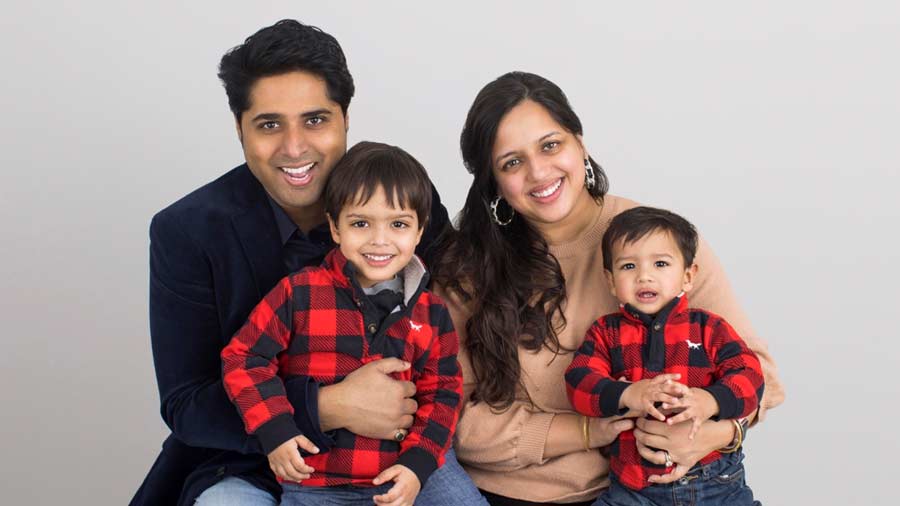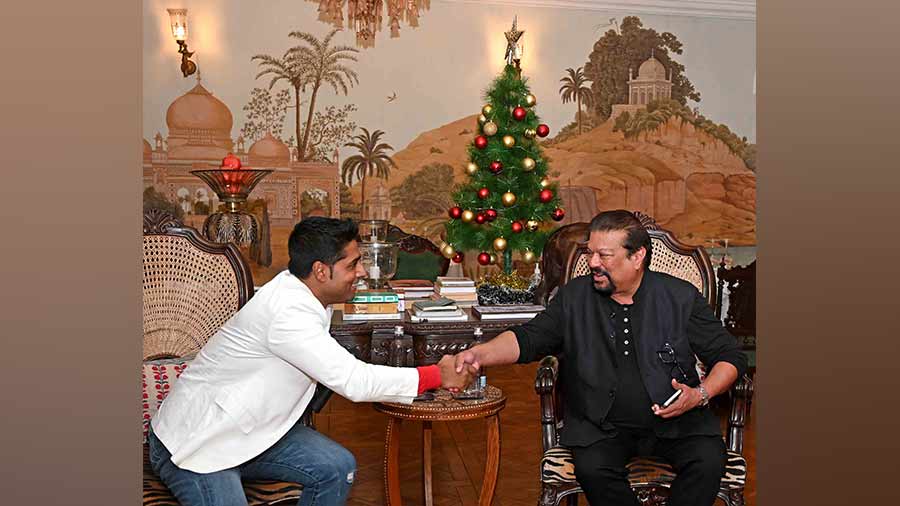Every eighth person in the world has consumed Indian food at least once. “But how many of them have tasted the real thing?” asks Roni Mazumdar, CEO of Unapologetic Foods, which runs six Indian restaurants in the US. Born and brought up in Kolkata, Roni moved to the US when he was 13. However, it was only in his early 30s that he found his true calling — to change the narrative about Indian food in the US.
“We must stop apologising about Indian food. We must serve it the way it is, without catering to Western palates,” says Roni, in what seems to be his mission as well as his incantation. Revolutionary without being reckless, Roni’s attitude to Indian food is paying off in style. In 2021, the New York Times ranked his restaurant Dhamaka (serving provincial Indian cuisine) as the best New York has to offer. This year, his South Indian restaurant Semma came second on the corresponding list, while also becoming the only Indian restaurant in the US to be in possession of a Michelin star in 2022. For Roni, the accolades are secondary. What is most important is his approach, something that has evolved in its details but remained constant in its essence. The essence of celebrating Indian food the way it is cooked, served and eaten in Indian homes.
During his recent visit to Kolkata with his wife Sreoshy Banerjea, an urban designer, My Kolkata caught up with Roni to understand how his food journey is redefining Indian food in the US. Edited excerpts from the conversation follow.
My Kolkata: In 2011, when you started your first restaurant called The Masalawala in New York City, did you have any ambitions of creating a food empire one day?
Roni Mazumdar: I had ambitions with respect to food, but never thought that I was worthy of a food empire. At the time, opening Masalawala was just about a son (Roni) thinking about his father (Satyen Mazumdar). We thought it’d be a little place of community and livelihood. But then it began to grow, and it was only when I kept on going that I saw the challenges of this industry. That is when I found my calling to be much stronger.
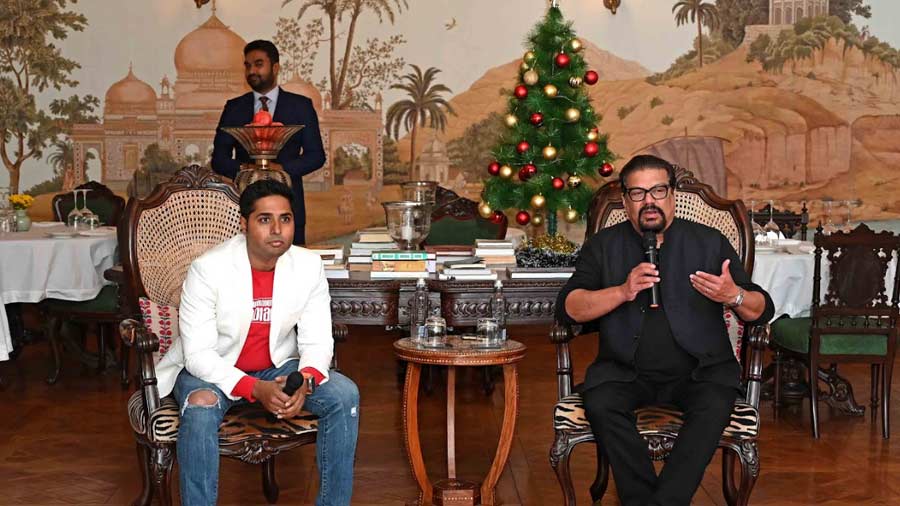
“Roni has broken out of that ethnic ghetto in which Indian restaurants are always placed,” observed Vir Sanghvi during his chat with Roni at the Glenburn Penthouse Amit Datta
How was the initial response to The Masalawala? What made you wait for seven years to open your next Indian restaurant in NYC?
The response was slow but steady. It wasn’t an overnight success. I remember we’d give out flyers, talk to concierges and do our best to let more people know about the restaurant. We didn’t have any media outlets writing about us back then. Sometimes, especially during the winter, if we didn’t have enough space to accommodate our customers waiting for their tables, my dad would ask them to wait inside the vans that were used to transport food from the local markets to our restaurants. And they’d wait there willingly, with Mango Lassis in hand! We didn’t really have any rules to follow, we just believed in pure hospitality, in showcasing what we know of how we treat people.
The same thing happened with Adda Indian Canteen. There was no immediate revolution. I felt as if we were pushing this giant rock up a hill, without even knowing where the top of the hill was. It took all our energy until at some point the rock started pushing itself. I can vividly recall this one day when I was surprised to see a giant line of people around the block where Adda is. I went and asked them what they were queueing up for. They told me they were waiting for Adda to open. I came running in and couldn’t believe this was real. Since then, the lines have only kept on growing. And there’s nothing more humbling than that.
Why did I wait so long to open my second restaurant? I was waiting for knowledge, context and the ability to push through an idea. Those years of waiting taught me why Indian food has struggled abroad. It allowed me to see what needed to be rectified by piecing things together. It also gave me the time to build myself, my team and our collective vision. It was during those six to seven years that I also learnt what it takes to be in other people’s shoes. There were several occasions where I did deliveries personally, understanding what it takes to deliver food from one corner of town to another on the most brutally cold night. When the dishwasher didn’t show up, my father and I washed the dishes ourselves. All this helped me implement a system where there is no hierarchy. As the CEO, I have my own role, but I’m no more important to Unapologetic Foods than the dishwasher or the delivery boy.
‘Chintan and I have the respect and the trust needed to not step on each other’s toes’
When did you meet your head chef and business partner Chintan Pandya? What do you think makes the two of you such a great team?
I met Chintan in 2017. The first time we spoke, it was all about understanding each other’s food vision. Chintan is very matter of fact until you get to know him. He has his own philosophy. What makes him unique is that he combines his technical knowledge with a disruptive vision. He’s deeply aware of the business side of the industry, which isn’t common for chefs. What makes us work together so well is that we don’t run the group as a monarchy. Our group is run by a vision. It’s never about us as individuals, but about cuisine, culture and context. Chintan and I come from different worlds and have different personalities, but we have the respect and the trust needed to not step on each other’s toes. Sometimes, I might think his recipe isn’t the best, but he has the right to go ahead with it. We might disagree every now and then, but we always support each other 100 per cent.

Adda Indian Canteen takes a rustic and informal approach to food, which has proven extremely popular among New Yorkers Photo courtesy Adda NYC
Out of all your restaurants so far, would you consider Adda to be the boldest venture?
With each venture, we’ve got bolder. Adda definitely was the boldest when it opened. And then, it was Dhamaka, because nothing on its menu remotely resembles what people are used to eating at Indian restaurants. There’s no naan, no samosa, no Chicken Tikka Masala. Then, with Semma, we took the boldness up by a notch or two because we started focusing on regional food. Right now, I’d say that Masalawala is probably the boldest, because authentic food from Bengal doesn’t exist in other places in the US. There’s only a surface level understanding of Bengali food. But the food that we serve at Masalawala, be it Bhapa Ilish (with the bones left in the fish) or Kosha Mangsho or Machher Deem, is about a completely different kind of flavour profile, that evokes no reminiscence about North Indian cuisines. We didn’t know if New Yorkers would find it appealing, but I’m glad to say that they’ve been lapping it up!
Serving Machher Deem with Gobindobog rice, kancha lonka, salt and an egg
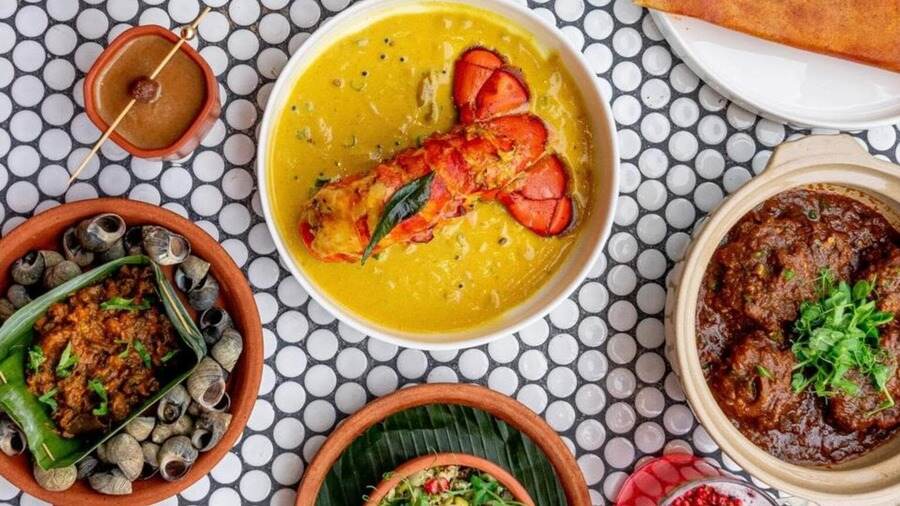
Some of Michelin star-winning Semma’s leading dishes Photo courtesy Semma
What does winning a Michelin star for Semma mean to you?
I don’t want a Michelin star to change how we look at food. I’m grateful that such a privilege has been awarded to us and I’m aware of how historic it is. But I don’t want us to be plagued by the pitfalls that come with such an award. I don’t want us to think about whether we’ll retain the Michelin star next year or which is our next restaurant that can win it. We’ve never made food to win awards. At the same time, we know that such recognition comes with its responsibilities. Whether we want to or not, we’ve become a beacon for Indian food, which gives us a real opportunity to establish what Indian food is all about for generations to come.
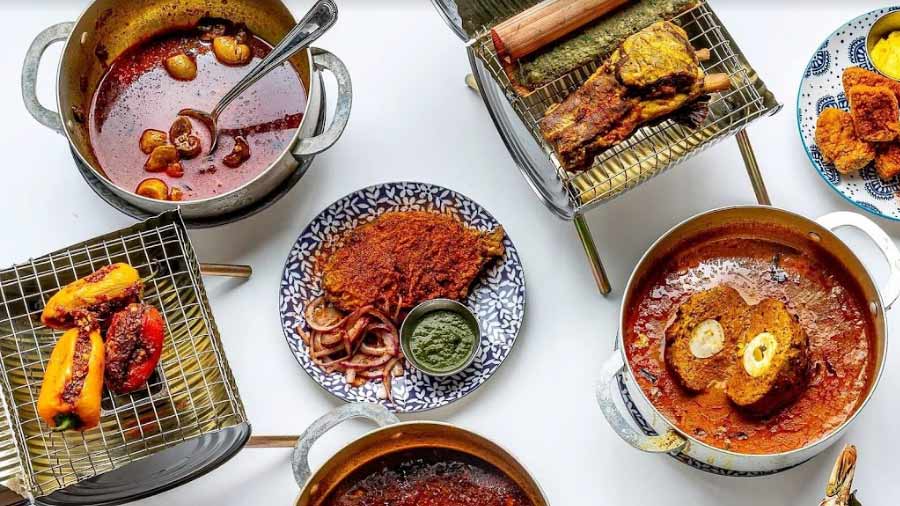
A part of the authentic Indian spread available at Dhamaka Photo courtesy Dhamaka
While Semma is often your best reviewed restaurant, Dhamaka seems to be the most popular. You have said before that Dhamaka is about “the forgotten side of Indian food”. Could you elaborate on that?
Right now, Dhamaka and Semma are neck and neck when it comes to popularity. The waiting lists are also closely matched. If one place has around 1,400 waiting, the other one will have nearly 1,500. As for Dhamaka being about “the forgotten side of Indian food”, I’d say that it means we celebrate cuisine that is neglected by geography as well as perceived notions of status. The definition of what a cultural dish is invariably set by high-end restaurants. But what restaurants often serve is not what people eat at home. We believe in changing that. How many restaurants serving Bengali food, be it in the US or here in India, serve machher deem? The way we do it, we serve the deem with Gobindobhog rice, kancha lonka, some salt and maybe an egg. That’s how a farmer or fisherman eats at home. And that’s the experience we’re replicating at Dhamaka.
‘You can be wearing your headset and eating your food while sitting on top of a supernova’
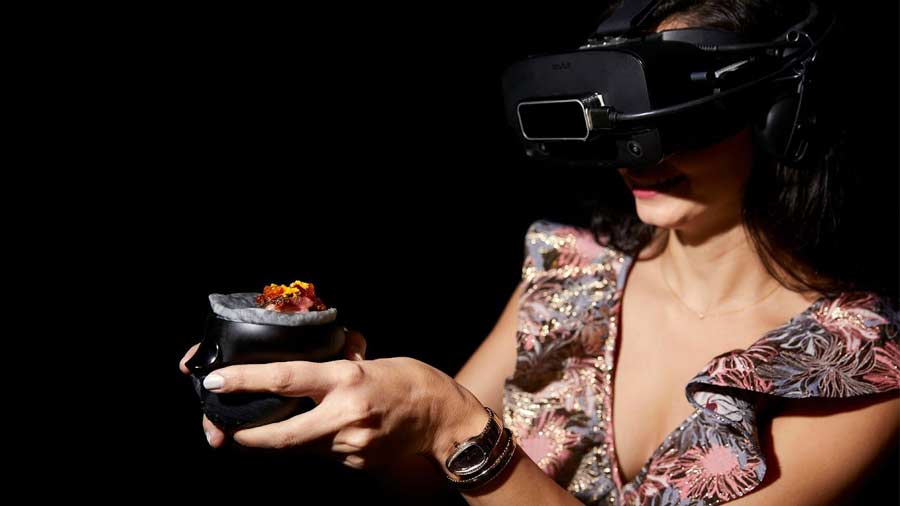
Aerobanquets RMX is part-tech, part-art and part-food, according to Roni Aerobanquets RMX/Mattia Casalegno
Tell us how you have been merging “gastronomy and mixed-reality” through Aerobanquets RMX….
Four years ago, I met this Italian artist called Mattia Casalegno through a common friend. I had tried something in his lab, which redefined what food means. It rewires your brain. That’s what we’ve tried to do with Aerobanquets RMX, in providing an immersive dining experience that involves a multisensorial, multicourse meal in a mixed reality. We’ve been sold out wherever we’ve tried this concept so far. It’s part-tech, part-art and part-food. Through it, we’ve built a fantastical world that can be anything from an artist’s lab to a simulation of reality. Through your Virtual Reality goggles, you can reach out and touch everything in this world, from the floating cutlery to the food. And when you eat, you don’t even have to take off your goggles. That’s where the experience is truly groundbreaking. You can literally be wearing your headset and eating your food while sitting on top of a supernova!
Authentic Indian fried chicken, not with French fries, but with beguni
What sets your latest food ventures in Rowdy Rooster and Kebabwala apart?
Rowdy Rooster is a counter service that serves Indian fried chicken, or what I like to call street- style Indian pakoda. Growing up in India, I remember eating a specific type of chicken pakoda from Bardhaman (in West Bengal) that was outstanding. I never found that flavour in the US. Rowdy Rooster is an attempt at recreating such flavours from scratch. It’s about selling Indian snacks in the right context. For less than $12, you can have a full meal there. And with our fried chicken, we don’t serve you French fries. Our side dish is beguni, cut into squares.
At Kebabwala, we intend to do with kebabs what we’ve done with fried chicken at Rowdy Rooster. I feel that a kebab is something you can have at any time of the day as part of any meal. So, the idea is to make kebabs as accessible and as authentic as possible and use it to shatter the notion that Indian food is all about curries.
‘What we have are not just moments, it’s a movement’
Any memorable stories about NYC locals eating at your restaurants, or anything that has left a mark on you personally?
There was an Indian gentleman who came to eat at Semma and was brought to tears after eating the food. He said: “The food reminded me of my grandfather. The last time I had such food was when he cooked for me”. Another time, a guy came into Masalawala, looking devastated. His wife and he had just divorced after 32 years of marriage. Once he arrived, he went up to my father to tell him that all he wanted to do that day was to meet a friend (Roni’s father) and share a meal with him. Quite a few of our customers also develop a great bond with our staff. Often, they’ll come in on days when a staff member has their birthday, have their meals and wait for the restaurant to close so that they can celebrate with the staff over a glass of wine. This proves that what we do is much more than food. It’s about building a community. What we have are not just moments, it’s a movement.
‘Everyone kept telling me that eating here is like eating at my grandma’s house. Now I know what that feels like…’: Shailene Woodley on eating at Dhamaka

Shailene Woodley left a memorable message after her meal at Dhamaka Wikimedia Commons
What have been the most interesting celebrity reactions to your restaurants? And who all have been there so far?
Plenty of them. Jennifer Lawrence has been to both Dhamaka and Adda. Padma Lakshmi came to Rowdy Rooster. Benedetto Vigna, the CEO of Ferrari, has eaten our food. I can go on and on! But there was one celebrity whose reaction stands out. Shailene Woodley had once come to eat at Dhamaka, and on finishing her meal, she asked for a piece of paper. She then left a note on both sides of the paper, especially thanking Chintan (who was not present on the day). She wrote: “Everyone kept telling me that eating here is like eating at my grandma’s house. Now I know what that feels like. And my grandma isn’t even Indian!” That response was quite memorable, and we ended up chatting for a long time.
Who would you love to invite to one of your restaurants?
Right now, my parents. Odd as it may sound, but they’re yet to dine at Dhamaka!
The Moon Moon Sen cocktail you serve at The Masalawala was quite the rage at your My Kolkata event at the Glenburn Penthouse where she was present! Do you have any other dishes/drinks inspired by or named after celebrities?
Not really. The ones I can think of are the Whistle Podu cocktail, which was Chintan’s idea and the Thalaiva cocktail (an apparent tribute to both Mahendra Singh Dhoni and Rajinikanth), which is a whiskey-based bourbon.
If you had to recommend one dish from each of your restaurants for a Bengali from Kolkata travelling to NYC, what would they be?

The goat-neck biryani at Dhamaka Photo courtesy Dhamaka
I’d start with the Aloo Chana Chaat at Adda, then move on to the Biye Bari Fish Fry or butter fry and the Bhapa Ilish from Masalawala. From Dhamaka, I’d recommend the Goat-neck Biryani and from Semma, the Mutton Sukha, which is like Kosha Mangsho but with a curry leaf, which changes the dish’s dimension.
Dal Pakoda in New Market was outrageously good

New Market’s special delicacy stood out for Roni on his trip to Kolkata TT Archives
Lastly, your Kolkata trip in one sentence each. Starting with the My Kolkata conversation at The Glenburn Penthouse with Vir Sanghvi.
Meaningful. I was so honoured to be surrounded by such amazing talent, and learnt so much while interacting with the people. They’re doing a much better job with their food ventures than I’d ever be able to do in Kolkata.
The best/most exciting meal.
Dal Pakoda, which I had on the streets of New Market. Outrageously good. I loved the freshness and the sponginess. And there’s no doughiness either.
The standout memory you will take back.
Entering the Rajbaris (while on a mini-tour of the city with wife Sreoshy and Iftekhar Ahsan, founder of Calcutta Walks, and My Kolkata). It’s not a side of Kolkata I had seen earlier. At least not in the last 30 years. It felt deeply personal.

